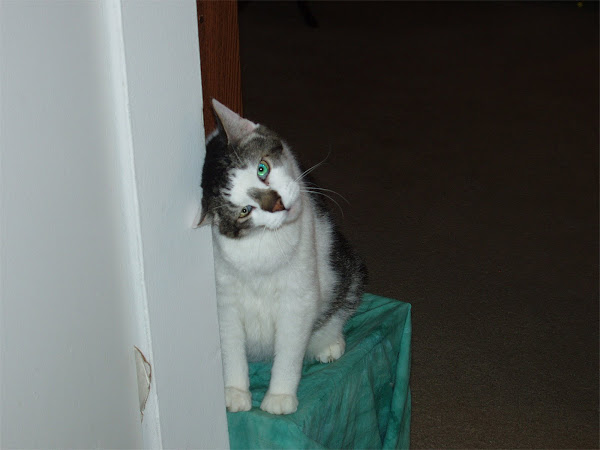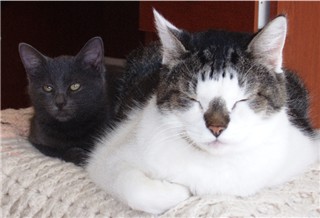 |
| Babs & Cali enjoying smell-a vision. |
The shelter operates a thrift shop and relies on public donations and adoption fees for funding. All pets are spayed, neutered, microchipped and vaccinated before they are placed in the adoption kennels. The shelter also has a veterinary hospital on the grounds to meet the needs of its resident animals. There are plenty of opportunities from administrative to hands-on positions for people who wish to get involved and volunteer their time and love for animals.
Lisa and I took in two homeless kittens from our neighborhood and each one was taken to our vet, checked out, spayed and vaccinated, so we are well aware of the need for such a shelter. In our own neighborhood we see stray cats and dogs aplenty. Some of them may in fact have homes, but many owners fail to spay or neuter their pets, which of course generate even more stray animals. Many of these homeless cats and dogs get hit by cars, die of illnesses and disease or succumb to predators like owls and hawks. Many more wind up in the city pound or shelters that kill animals that don’t get adopted by a certain time. To help stem the tide of so many strays, the Animal Defense League of Texas sponsors a low-cost spay and neuter program for the public. It is so sad to think how many of these animals die before they can find loving homes like our Cali and Babs. We just love our foundling cats and they have added so much to our lives.
For Lisa and I there was no question that we would be hands on volunteers. Lisa loves cats, so she chose to work with the cats in the “Cattery.” There is a real need to socialize many of the animals that come into the shelter so they will have a better chance of adoption. It also gives volunteers a chance to know their personalities to better match the cat with the adoptee. The cats can roam free in different rooms furnished with cat tree houses, carpeted perches and an enclosed porch. It’s a good environment to observe the different cats and their many behaviors. Some are very friendly and demand your attention while others are more aloof and want to be left alone. With only a few visits under belt, Lisa can already tell you all their names and describe their personalities. She loves getting her “kitty fix.” The only problem will be in not wanting to take them all home with us.
I love cats too, but I was also raised around dogs on our farm when I was growing up, so I have decided to split my time between the cats and the dogs. Today was my first time walking the shelter dogs. I didn’t have a leash yet so one of the animal care-givers gave me a leash and introduced me to my first dog. His name was Corey. Corey was recovering from surgery and had a bit of a limp and a wound on top of his head. I’m guessing he may have been hit by a car. It is suggested that we take dogs on 20 minute walks. The walks are very important when it comes to socializing the dogs. They get so excited and love humans to take them to the dog park on the grounds behind the kennels. The dog park is an open area with plenty of trees and benches. The dogs have to stay on their leash while in the park, but there are pens to one side where you can take off the leash and let them run. The pens have dog toys and plastic water pools and they have a great time. I walked three other dogs before it was time to leave and met some of the other volunteer dog walkers in the process. One of the “old timers” asked me to help walk a pair of Deer Hounds who need to be adopted together. They are in the same pen and also get walked together. They are too much dog for one volunteer so I agreed to help. In the process, I got a lot of insight on the dogs.
One of the sad realities of shelter life is that black animals, both cats and dogs are the first to be euthanized since they are less likely to be adopted. Even when they come into our no kill shelter, adopters are less likely to choose the black animals. Sadly, they are too often overlooked, even when it comes to attention and walking by volunteers. The shelter is trying to make everyone aware of this strange phenomenon and post reminders around the kennels. Some older animals are never adopted and spend the rest of their lives in the shelter, but they are well cared for. Thankfully, most of the animals move in and out of the shelter to new homes fairly quickly. By helping to socialize these animals, we help insure a successful adoption.
Lisa and I had a great morning with our new pals.
Food for THOUGHT…





















No comments:
Post a Comment